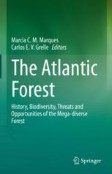Search
Search Results
-
Cascading effects of climate change: new advances in drivers and shifts of tropical reproductive phenology
Tropical forests were long viewed as relatively stable systems, with little biologically important variation in climate. However, in recent years,...
-
Overexploitation and anthropogenic disturbances threaten the genetic diversity of an economically important neotropical palm
The Caatinga biome is one of the largest areas of the South American seasonally dry tropical forest that has been severely affected by unsustainable...

-
Vochysia pongo-qonecensis (Vochysiaceae), a new species from the Peruvian Andean-Amazonian piedmont forests
Vochysia pongo-qonecensis is described and illustrated. It occurs in the southern Peruvian pre-montane forests of the Andean-Amazonian piedmont. This...
-
Fire and distance from unburned forest influence bird assemblages in Southern Andean Yungas of Northwest Argentina: a case study
BackgroundWildfires affect vegetation structure, functions, and other attributes of forest ecosystems. Among these attributes, bird assemblages may...

-
Unraveling the drivers of plant taxonomic and phylogenetic β-diversity in a human-modified tropical dry forest
Biodiversity maintenance in human-modified landscapes largely depends on spatial variations in species composition (β-diversity), but the impact of...

-
Nutrient retranslocation of Swietenia macrophylla King plantation in sub-humid foothills of Eastern Himalaya
Broad leaf mahogany ( Swietenia macrophylla King, Family: Meliaceae) is one of the best-known and most valuable tropical timber. It is almost unique...

-
Anthropogenic threats and habitat degradation challenge the conservation of palm genetic resources—an appraisal of current status, threats and look-ahead strategies
Palms are integral structural and functional components of tropical forest ecosystems, and are one of the most economically important plant families....
-
Biodiversity and Biomass Carbon Dynamics: Insights from Long-Term Monitoring in the Western Ghats
Management and conservation of forests are subject to pressures and disturbances. Planning and management of forests for conservation require...
-
Floristic Diversity on Rubber Plantations and Their Importance for Subsistence at Foothill Landscapes of Mexico
Human activities in the tropics of Veracruz, Mexico, have transformed its original vegetation into anthropized landscapes. This contemporary...
-
History and Future of Fire in Hardwood and Conifer Forests of the Great Lakes-Northeastern Forest Region, USA
The Great Lakes-Northeastern forest region from Minnesota to New England has varied climates and site conditions that allow diverse fire regimes. In...
-
Ethnobotany of the Highlands of Chiapas
The state of Chiapas is one of the most biologically diverse and bioculturally rich areas of Mexico. The region known as the Highlands of Chiapas is...
-
Amazon wood species classification: a comparison between deep learning and pre-designed features
In many countries, the wood industry is a crucial sector and has a significant economic impact. In this sense, illegal logging is a way to reduce...

-
Foxes and goats: the outcome of free-ranging livestock farming in Brazilian dry forests
Humans are promoting drastic changes in biological communities that result in ‘winner-loser’ species replacements across multiple spatial scales. In...

-
Bark Beetles
Bark beetles often feed on dead or dying plant tissues, serving as primary decomposers. However, some bark beetle species kill healthy trees,...
-
Causes and Consequences of Large-Scale Defaunation in the Atlantic Forest
The Atlantic Forest of South America hosts one of the world’s most diverse and threatened tropical forest biota. After five centuries of...
-
Dominican amber Flowers
Based on direct and indirect evidence, 38 angiosperm flowers in over 20 plant families enhanced the tropical moist Dominican amber forest with their...
-
Methyl salicylate as a signaling compound that contributes to forest ecosystem stability
Key messageThis review for the first time gathers the current state of knowledge on the role of plant and microbial methyl salicylate (MeSA)...

-
Increasing Biodiversity in Livestock Production Systems: Plant Traits and Natural Regeneration Capacity of Woody Vegetation in Actively Managed Grasslands
Species’ natural regeneration capacity is an ecological property of plant communities that is key to restoring diversity after disturbances and to...
-
Until death do us part: abundance and survival of necrophagous beetle species associated with fox scats in fragmented landscapes
Forestry companies have replaced and fragmented the native landscapes, generating a large number of unpaved roads, which can have a negative effect...

-
Growth and yield of Retrophyllum rospigliosii pure plantations in the Colombian Andes
Most reforestation in Colombia, especially in the Andean region, are monocultures of pines and eucalyptus with defined nursery and silvicultural...

